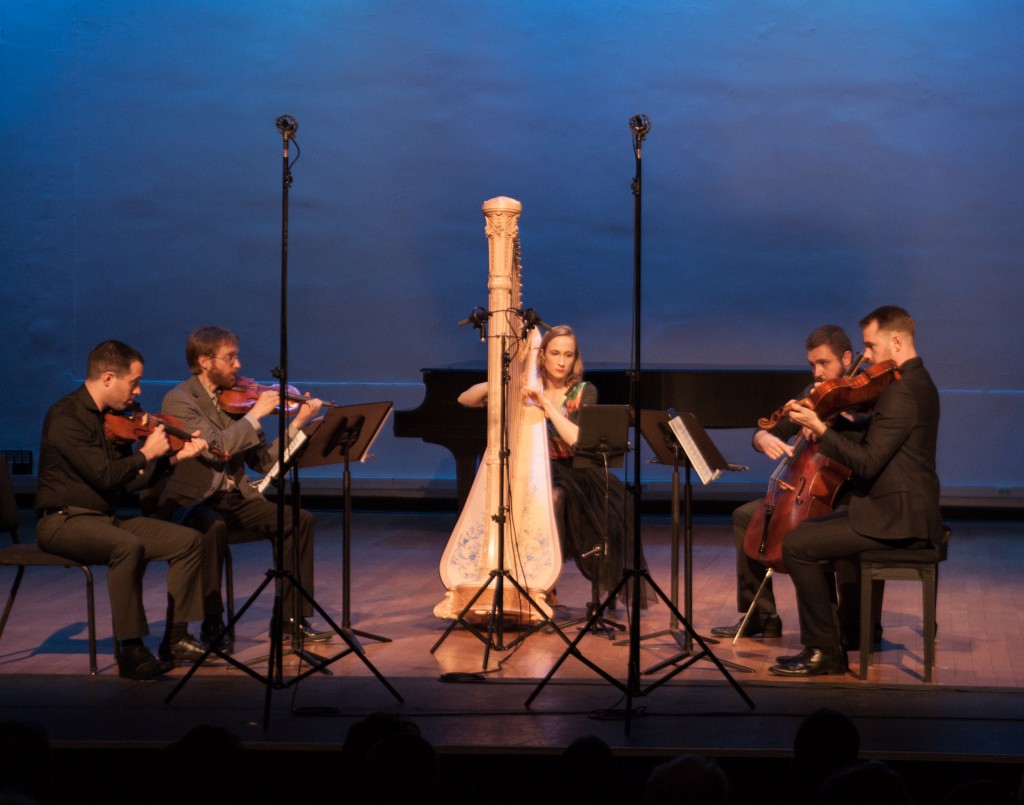Hannah Lash portrait shows a young composer rising at Miller Theatre

Hannah Lash and JACK Quartet performed Lash’s “Filigree in Textile” Thursday night at the Miller Theatre. Photo: Tanya Ghosh
Before the music began, there were already two notable things about Hannah Lash’s Composer Portrait at Miller Theatre on Thursday night. One was that Lash, 34, is one of the youngest composers to appear in the series. The other is that Lash is one of the few composers whose instrument is the harp.
Those two facts made their impression on the music itself. Most immediately, Lash is an excellent musician and on a subtler level her experience with the instrument crucially influences her compositional ideas. As for her age, it’s a sign that even though her career is barely a decade old, her best work expresses an individual voice that is clear, strong, and stands apart from the crowd.
The concert was a substantial addition to Lash’s burgeoning career, with two of the three pieces world premieres.
The opener was a 2011 work, Filigree in Textile for harp and string quartet, written for JACK Quartet and Lash’s harp teacher, the celebrated Yolanda Kondonassis.
The instrumental part is daunting. During the intermission discussion with Miller executive director Melissa Smey, Lash admitted that the “perpetual, pattern-based” writing for the instrument was extreme.
But that writing is an essential part of the music’s weave, inspired by Medieval tapestries. The three movements—“Gold,” “Silver,” and “Silk”—work through the fundamental techniques of inversion, retrograde, and counterpoint. Even when quiet, or when the pulse is slow, Filigree is always moving its material around, like a shuttle, through various iterations and transformations.
There is a luminous quality to the music that came through in this confident, lively performance. There’s also a purity to Lash’s method, which is to take small, simple materials and develop complex results. The basic movement between major and minor chords produces both structure and an expressive sound, one that lies outside what is heard in minimalism and post-minimalism. This quality seems ingrained from the harp itself, where the pedals adjust the strings to sharps and flats. Changing keys adds a layer of physical involvement.
Interest in the inner workings of chords and harmonies was apparent in Music for Eight Lungs. The first of the world premieres and a Miller Theatre commission. this work was written for the unusual ensemble loadbang: trumpeter Andy Kozar, bass clarinetist Carlos Cordeiro, trombonist William Lang, and baritone Jeffrey Gavett. Lash and the group has already collaborated on the large-scale monodrama Stoned Prince.
Eight Lungs is abstract, the vocal part wordless. But the music still builds an expressive narrative. Starting with slow, repeated, descending scales, the instruments become a sympathetic and contrasting accompaniment to the voice. The vocal line ultimately seeks to rise, even as the instruments descend—there’s more counterpoint, and more weight on motion between major and minor keys. There are moments when the winds come together in gorgeous triads that, with the voice, sounded like a masterpiece out of the great American songbook.
After intermission, pianist Lisa Moore played Six Etudes and a Dream. In this world premiere, the Etudes seemed slightly out of character, perhaps transitional and not yet fully formed, like a sculpture that needs one last round of chiseling to achieve full definition.
The Etudes are studies in mood and expression, conveyed through technique. They lack the fine structural clarity of the other two pieces, and that limits the range of emotion and intellectual expression, which is predominantly introverted and dark hued. Lash said that she was trying to write challenging music for the piano, but the piece doesn’t sound fully idiomatic, even with Moore finding a way to solve every cross-rhythm and displace phrase.
There are hints of rhythmic ideas and phrases from Ligeti, Stravinsky, and Debussy in the first three of the seven segments. In the last four, a combination of more refined writing, and the sensation that Moore unlocked a door into the music, gave everything appreciably more sense: means and goals matched, the expression took on greater energy, brighter color, and more wit. That left a satisfying taste, and an intriguing hint toward Lash’s future.
Composer Portraits continue with the music of Francesca Verunelli 8 p.m. April 21. millertheatre.com






